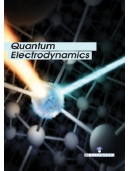Physics

Quantum electrodynamics, commonly referred to as QED, is a quantum eld theory of the electromagnetic
force. QED is a relativistic theory in that Albert Einstein’s theory of special relativity is built into each of its equations. Because the behavior of atoms and molecules is primarily electromagnetic in nature, all of atomic physics can be considered a test laboratory for the theory. QED applies to all electromagnetic phenomena associated with charged fundamental particles such as electrons and positrons, and the associated phenomena such as pair production, electron-positron annihilation, Compton scattering, etc. It was used to precisely model some quantum phenomena which had no classical analogs, such as the Lamb shift and the anomalous magnetic
moment of the electron. QED was the rst successful quantum eld theory, incorporating such ideas as particle creation and annihilation into a self-consistent framework. The development of the theory was the basis of the 1965 Nobel Prize in physics, awarded to Richard Feynman, Julian Schwinger and Sin-itero Tomonaga.